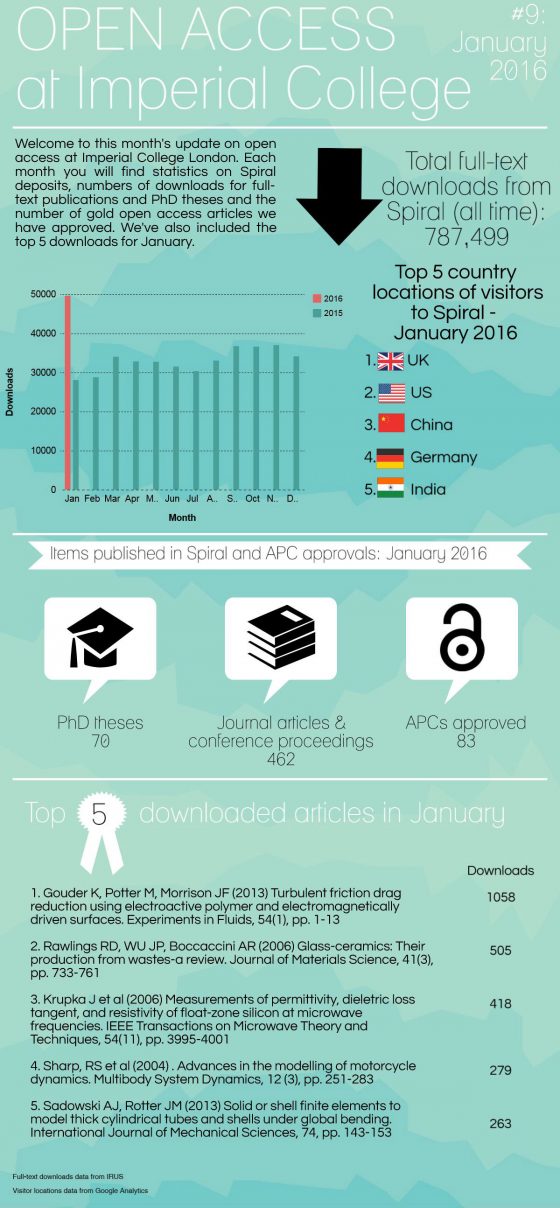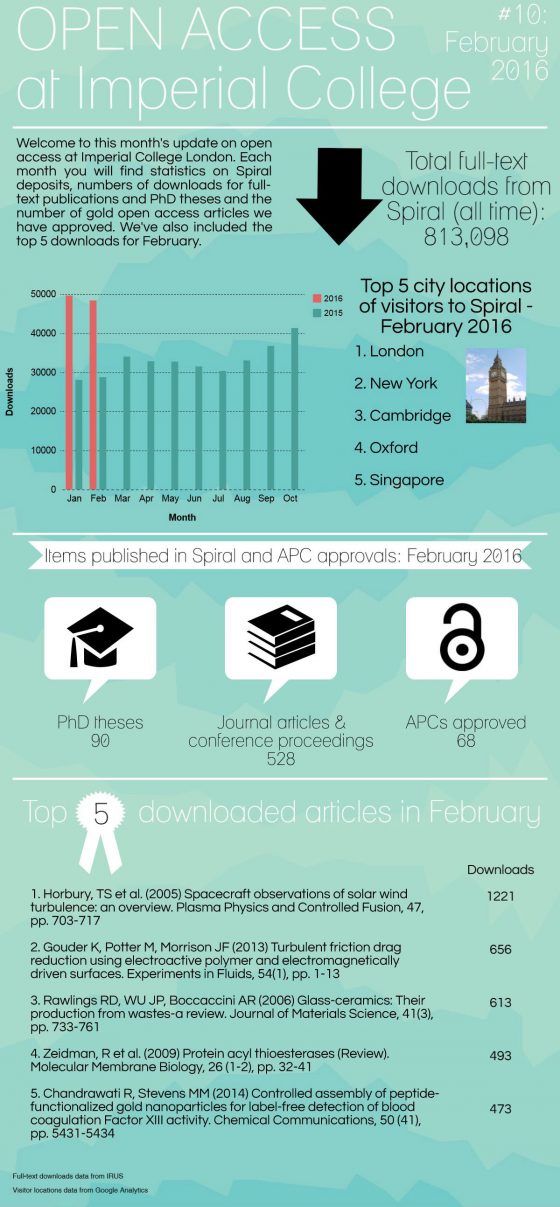In what is hopefully not going to become a long series I am today dealing with the joys of compliance reporting in the context of HEFCE’s Policy for open access in the post-2014 Research Excellence Framework (REF). The policy requires that conference papers and journal articles that will be submitted to the next REF – a research assessment through which funding is allocated to UK universities – have to be deposited in a repository within three months of acceptance for publication. Outputs that are published as open access (“gold OA”) are also eligible, and during the first year of the policy the deposit deadline has been extended to three months of publication. The policy comes in force on 1st April and considering the importance of the REF the UK higher education sector is now pondering the question: how compliant are we?
As far as Imperial College is concerned, I can give two answers: ‘100%’ and ‘we don’t know’.
‘100%’ is the correct answer as until 1 April all College outputs remain eligible for the next REF. While correct, the answer is not very helpful when trying to assess the risks of non-compliance and for understanding where to focus communications activities. Therefore we have recently gone through a number crunching exercise to work out how compliant we would be if the policy had been in force since May last year. In May 2015 we made a new workflow available to academics, allowing them to deposit outputs ‘on acceptance’. The same workflow allows academics to apply for article processing charges for open access, should they wish to.
You would imagine that with ten months of data we would be able to give an answer to the question for ‘trial’ compliance, but we cannot, at least not reliably. In order to assess compliance we need to know the type of output, date of acceptance (to work out if the output falls under the policy), the date of deposit and the date of publication (to calculate if the output was deposited within three months). Additionally it would help to know whether the output has been made open access through the publisher (gold/immediate open access).
Below are eight issues that prevent us from calculating compliance:
- Publisher data feeds do not provide the date of acceptance
Publishers do not usually include the date of acceptance in their data feeds, therefore we have to rely on authors manually entering the correct date on deposit. Corresponding authors would usually be alerted to acceptance, but co-authors will not always find out about acceptance, or there may be a substantial delay.
- Deposit systems do not always require date of acceptance
The issue above is made worse by not all deposit systems requiring academics to enter the date of acceptance. In Symplectic Elements, the system used by Imperial, the date is mandatory only in the ‘on acceptance’ workflow; when authors deposit an output that is already registered in the system as published there is currently no requirement to add the date – resulting in the output listed as non-compliant even if it was deposited in time. Some subject repositories do not even include fields for date of acceptance.
- Difficulties with establishing the status of conference proceedings
Policy requirements only apply to conference proceedings with an ISSN. Because of the complexities with the publishing of conference proceedings we often cannot establish whether an output falls under the policy, or at least there is a delay (and possible additional manual effort).
- Delays in receiving the date of publication
It takes a while for publication metadata to make it from publishers’ into institutional systems. During this time (weeks, sometimes months) outputs cannot be classed as compliant.
- Publisher data feeds do not always provide the date of publication
This may come as a surprise to some, but a significant amount of metadata records do not state the full date of publication. The year is usually included, but metadata records for 18% of 2015 College outputs did not specify year or month. This percentage will be much higher for other universities as the STEM journals (in which most College outputs are published) tend to have better metadata than arts, humanities and social sciences journals.
- Publisher data feeds usually do not provide the ‘first online’ date
Technically, even where a full publication date is provided the information may not be sufficient to establish compliance. To get around the problem that publishers define publication dates differently, HEFCE’s policy states that outputs have to be deposited within three months of when the output was first published online. This information is not usually included in our data feeds.
- Publisher data feeds do not usually provide licence information
Last year, Library Services at Imperial College processed some 1,000 article processing charges (APCs) for open access. We know that these outputs would meet the policy requirements. However, when the corresponding author is not based at Imperial College – last year around 55% of papers had external co-authors – we have no record on whether they requested that the output be made open access by a publisher. For full open access journals we can work this out by cross-referencing the Directory of Open Access Journals. However, for ‘hybrid’ journals (where open access is an (often expensive) option) we cannot track this as publisher metadata does not usually include licence information.
- We cannot reliably track deposits in external repositories
Considering the effort universities across the UK in particular have put into raising awareness of open access there is a chance that outputs co-authored with academics in other institutions have been deposited in their institutional repository. Sadly, we cannot reliably track this due to issues with the metadata. If all authors and repositories used the ORCID identifier it would be easier, but even then institutional repositories would have to track the ORCID iD of all authors involved in a paper, not just those based at their university. If we had DOIs for all outputs in the repositories it would be much easier to identify external deposits.
Considering the issues above, reliably establishing ‘compliance’ is at this stage a largely manual effort that would take too much staff time for an institution that annually publishes some 10,000 articles and conference proceedings – certainly while the policy is not yet in force. Even come April I would rate such an activity as perhaps not the best use of public money. Arguably, publisher metadata should include at least the (correct) date of publication and also the licence, although I cannot see a reason not to include the date of acceptance. If we had that, reporting would be much easier. If we had DOIs for all outputs (delivered close to acceptance) it would be even easier as we could track deposits in external repositories reliably.
Therefore I call on all publishers: if you want to help your authors to meet funder requirements, improve your metadata. This should be in everyone’s interest.
Colleagues at Jisc have put together a document to help publishers understand and implement these and other requirements: http://scholarlycommunications.jiscinvolve.org/wp/2015/03/26/how-publishers-might-help-universities-implement-oa/
What we can report on with confidence is the number of deposits (excluding theses) to our repository Spiral during 2015: 5,511. Please note: 2015 is the year of deposit, not necessarily year of publication.
Read How compliant are we with HEFCE’s REF open access policy? (Why Open Access reporting is difficult, part 2) in full

